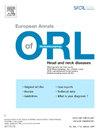The impact of middle meatal steroid-eluting implants on the postoperative outcomes of chronic rhinosinusitis: A systematic review and meta-analysis
IF 2.4
4区 医学
Q2 OTORHINOLARYNGOLOGY
European Annals of Otorhinolaryngology-Head and Neck Diseases
Pub Date : 2025-01-01
DOI:10.1016/j.anorl.2024.02.014
引用次数: 0
Abstract
Endoscopic sinus surgery (ESS) has become an established surgical option in refractory chronic rhinosinusitis (CRS). The goal of this review is to assess the impact of steroid-eluting middle meatal implants after ESS. Cochrane Central Register of Controlled Trials (CENTRAL), SCOPUS, PUBMED, and GOOGLE SCHOLAR were searched from inception to November 2022. All randomised controlled trials (RCTs) involving adult patients receiving ESS for CRS utilising a steroid-eluting middle meatal implants were eligible. The primary outcome was adhesion or synechiae. The secondary outcomes were mucosal inflammation, polyp reformation, the need for oral steroids and additional surgery, postoperative bleeding, sinus pain and discomfort, postoperative sinus-related infection, and change in intraocular pressure. Fourteen full articles were examined out of 496 potential abstracts. Seven RCTs satisfied the criteria. At 30 days, steroid-eluting implants reduced adhesion (OR: 0.28, 95% CI: 0.14 to 0.56; P < 0.001), mucosal inflammation (MD: −13.09, 95% CI: −18.22 to −7.97; P < 0.001), polyp reformation (OR: 0.31; 95% CI: 0.22 to 0.44; P < 0.001), and requirement of additional oral steroid (OR: 0.44; 95% CI: 0.25 to 0.78; P = 0.005) or surgery (OR: 0.25; 95% CI: 0.12 to 0.50; P < 0.001). While their use for adhesion (OR: 0.24; 95% CI: 0.11 to 0.54; P < 0.001) and polyp reformation (OR: 0.24; 95% CI: 0.12 to 0.51; P < 0.001) were favourable, there was no difference in mucosal inflammation (MD: −5.68, 95% CI: −12.39 to 1.03; P = 0.100) or the need for surgery (OR: 0.96; 95% CI: 0.07 to 12.37; P = 0.980) when evaluated after 30 days. Overall, the findings suggest that steroid-eluting middle meatal implants improve ESS outcomes by lowering rates of adhesion formation, postoperative medical and surgical interventions, recurrent polyposis, and inflammation, while having no significant negative impact in the immediate postoperative period. More research is needed into the long-term impacts.
肉中膜类固醇洗脱植入物对慢性鼻炎术后疗效的影响:系统回顾与荟萃分析。
内窥镜鼻窦手术(ESS)已成为治疗难治性慢性鼻窦炎(CRS)的成熟手术方案。本综述旨在评估ESS术后类固醇洗脱中缝植入物的影响。从开始到 2022 年 11 月,我们检索了 Cochrane Central Register of Controlled Trials (CENTRAL)、SCOPUS、PUBMED 和 GOOGLE SCHOLAR。符合条件的随机对照试验(RCT)均涉及使用类固醇洗脱中段肉腔植入物接受ESS治疗CRS的成年患者。主要结果是粘连或缝合。次要结果是粘膜炎症、息肉复发、是否需要口服类固醇和进行额外手术、术后出血、鼻窦疼痛和不适、术后鼻窦相关感染以及眼压变化。在 496 篇潜在摘要中,有 14 篇完整文章接受了研究。其中七项研究符合标准。30天后,类固醇洗脱植入物可减少粘连(OR:0.28,95% CI:0.14 至 0.56;P
本文章由计算机程序翻译,如有差异,请以英文原文为准。
求助全文
约1分钟内获得全文
求助全文
来源期刊

European Annals of Otorhinolaryngology-Head and Neck Diseases
OTORHINOLARYNGOLOGY-
CiteScore
3.70
自引率
28.00%
发文量
97
审稿时长
12 days
期刊介绍:
European Annals of Oto-rhino-laryngology, Head and Neck diseases heir of one of the oldest otorhinolaryngology journals in Europe is the official organ of the French Society of Otorhinolaryngology (SFORL) and the the International Francophone Society of Otorhinolaryngology (SIFORL). Today six annual issues provide original peer reviewed clinical and research articles, epidemiological studies, new methodological clinical approaches and review articles giving most up-to-date insights in all areas of otology, laryngology rhinology, head and neck surgery. The European Annals also publish the SFORL guidelines and recommendations.The journal is a unique two-armed publication: the European Annals (ANORL) is an English language well referenced online journal (e-only) whereas the Annales Françaises d’ORL (AFORL), mail-order paper and online edition in French language are aimed at the French-speaking community. French language teams must submit their articles in French to the AFORL site.
Federating journal in its field, the European Annals has an Editorial board of experts with international reputation that allow to make an important contribution to communication on new research data and clinical practice by publishing high-quality articles.
 求助内容:
求助内容: 应助结果提醒方式:
应助结果提醒方式:


